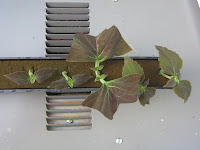A Coleus Paradise in New Jersey
OK, you skeptics, I hear you laughing, but consider this: the Garden State, which I’ve called home for more than 15 years now, contains its fair share of superb gardens. As part of a program known as Open Days, the generous owners of some of them open their gates to benefit the Garden Conservancy, the organization founded “to preserve exceptional American gardens for public education and enjoyment” (taken from the Conservancy’s website, which you might like to visit).
This past Saturday, Graeme Hardie welcomed several hundred visitors into his exquisite suburban garden, one that offers exuberance, thoughtful design, and a wide range of plants, including a masterly palette of coleus.
Come on over!
The formal planting along the street offers a hint of what is to come in the back garden: a thoughtfully composed celebration of tropical and hardy plants appreciated for their shapes and colors. A broad stripe of ‘Sedona’ (the rusty orange coleus) and ‘Purple Haze’ stands out against the various green and white bands and offers a launching pad for the airborne heads of the Euonymus topiaries. Note the absence of an unbroken lawn sweeping from the house to the street: why plant only grass and a few trees and shrubs when there are so many other ways to accent your house?
This view from a second-story window gives a good idea of the overall design of the back garden, which makes excellent use of a relatively small space. From the gate (to the right of what you see here, and which you’ll see in the next picture), the path leads up the steps and onto the terrace, then another series of steps leads visitors down the slope to another path and then back up to the gate. Areas not covered in hardscaping overflow with plants, and modern sculptures (including the running figure at the edge of the terrace) add punctuation. As we walked around, Graeme gave me the inside scoop on the two masses of coleus seen in this picture. The specimens in the pots on the terrace are the original plants bought in May, and those in the area at the lower right were all started from cuttings made from the terrace plants.
Two visitors are about to be amazed as they enter through the side gate to be greeted by the mass planting hinted at in the previous picture. ‘Sedona’ and ‘Purple Haze’ make an appearance here as they do in the front garden, but in a less formal role. Did you notice the blue wall? Try to picture what this scene would look like if the wall were painted with a more conventional color, such as white, gray, or dark green. The blue offers an unexpected but appealing contrast to both the bright and dark colors throughout the garden, and it makes the wall an exciting, important part of the overall design.
From another angle, the mass of ‘Sedona’ and ‘Purple Haze’ seems less assertive, broken up by the lines of Euonymus and other low shrubs running through the planting. Notice how the chartreuse in the centers of the leaves of ‘Saturn’ and on the sported foliage of ‘Careless Love’ picks up on the coloration of the large hosta leaves toward the back and the mass of tiny cloverlike Oxalis leaves in front. Virtually every plant appears to relate to its neighbors in this garden.
On the far side of the garden, another blue wall interacts dramatically with coleus and other container-grown plants. ‘Alabama Sunset’ on the left flows into a mass of ‘Purple Haze’, with Setcreasea pallida ‘Purpurea’ and a canna (’Australia’, perhaps?) offering tongues of contrasting purple and dark red. The green asparagus fern in the lower right and the Japanese cedars (Cryptomeria japonica) behind the wall offer some calming green among the more restless colors. Do you imagine the prow of a ship making its way through surging waters here?
While most of the coleus in Graeme’s garden flow through the garden in simpatico waves of rusty orange, gold, chartreuse, and wine-red, the lower part of the garden is home to an almost combative, eye-opening combination of the cerise-edged, dark-centered ‘Tabasco’ (or ‘Tobasco’, ‘Mississippi Summer’, or ‘Molten Lava’; take your pick of names) and eerily yellow-green golden creeping Jenny (Lysimachia punctata ‘Aurea’). There’s nothing subtle about this pairing, which reminds me of some of the madly rushing, demonic spirits in the Night on Bald Mountain/Ave Maria sequence at the end of Walt Disney’s masterpiece among masterpieces, Fantasia. I intend to unashamedly copy this combination next year!
I hope the Hardie garden - call it Paradise or a paradise, if you choose - inspires you to use coleus as any artist uses his or her tools and materials to create something beautiful and memorable. It does me.





























